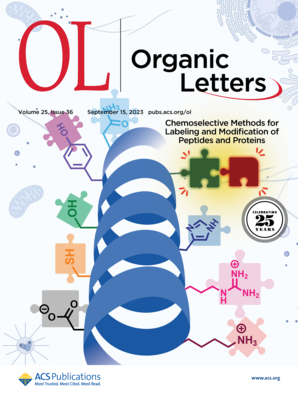二乙基锌淀粉酸酯:室温下选择性碘锌交换试剂
IF 5
1区 化学
Q1 CHEMISTRY, ORGANIC
引用次数: 0
摘要
最便宜的有机锌品种(二乙基锌)很少用于卤素锌交换,它与淀粉酸盐结合使用,随着时间的推移,产生新的稳定试剂,允许在室温下顺利进行碘锌交换,因此不需要繁琐和耗时的复杂混合物的制备。在多功能化烯烃(包括敏感的环丁烯、甾体和甘醛)、芳基和杂芳基上探讨了反应的范围。本文章由计算机程序翻译,如有差异,请以英文原文为准。

Diethylzinc Amylates: Selective Iodine–Zinc Exchange Reagents at Room Temperature
The cheapest available organozinc species (diethylzinc), yet rarely employed in halogen–Zn exchange, is used in a combination with amylate salts to generate new, over time, stable reagents that allow smooth iodide–zinc exchange at room temperature, preventing therefore the need for the fastidious and time-consuming preparation of complex mixtures. The scope of the reaction has been explored on polyfunctionalized alkenes (including sensitive cyclobutenes, steroids, and glycals), aryls, and heteroaryls.
求助全文
通过发布文献求助,成功后即可免费获取论文全文。
去求助
来源期刊

Organic Letters
化学-有机化学
CiteScore
9.30
自引率
11.50%
发文量
1607
审稿时长
1.5 months
期刊介绍:
Organic Letters invites original reports of fundamental research in all branches of the theory and practice of organic, physical organic, organometallic,medicinal, and bioorganic chemistry. Organic Letters provides rapid disclosure of the key elements of significant studies that are of interest to a large portion of the organic community. In selecting manuscripts for publication, the Editors place emphasis on the originality, quality and wide interest of the work. Authors should provide enough background information to place the new disclosure in context and to justify the rapid publication format. Back-to-back Letters will be considered. Full details should be reserved for an Article, which should appear in due course.
 求助内容:
求助内容: 应助结果提醒方式:
应助结果提醒方式:


